What flowers are planted before winter? Planting flower crops before winter
After all autumn planting will give you a lot of free time in the spring - then it will definitely come in handy for you. Yes, and crops planted in the fall are much more enduring, because they undergo natural hardening. And what a magnificent and beautiful flowering they will have!
Planting flower seeds in autumn
So, short list advantages of autumn planting:
- flowering in the first year after planting;
- there is no need to grow seedlings during the winter season, which again means significant time savings;
- natural stratification of seeds, which contributes to better germination, good health seedlings, increasing their resistance to spring frosts and excellent flowering, which will come 2 weeks earlier than with spring planting;
- excellent resistance of plants to sores and pests;
- excellent moisture during spring floods contributes to the complete saturation of seeds with moisture, stimulating their development. By the way, seeds sown in spring often suffer precisely from a lack of moisture, since elevated temperatures provoke its accelerated evaporation.
What time do you sow the seeds in the fall? It is best to schedule all work of this kind for the end of October-beginning of November. At this time, the autumn weather finally settled. But if you sow seeds that a priori need stratification, crops can be carried out even after the first snow falls. True, the beds in this case are still prepared in advance. When the soil is frozen, it is too convenient to prepare the beds.
Keep in mind that autumn crops are always thicker, because cold weather, whatever one may say, does not affect germination in the best way. It is better to once again thin out seedlings in the spring than to look with horror at bald beds.
And what flowers are sown from seeds in the fall?
In addition, plants that do not tolerate transplantation are also sown in the fall - it is better not to sow them for seedlings, but to plant them immediately in a permanent place, that is, in open ground. Here is a short list of such plants for autumn planting:
- asters (with the advent of spring it is recommended to cover with a film);
lavender;
hellebore;
gentian;
winter-hardy types of cyclamen;
aquilegia;
primrose;
delphinium and others.
All seeds of the above crops need stratification.
perennial plants they will sprout well when planted in spring, but autumn planting still gives them a lot of advantages. Both in spring and autumn, you can sow the following perennials:
- gaillardia;
arabis;
doronicum;
small-flowered;
Carpathian bell;
peach bell;
yarrow;
lychnis;
obrieta;
lupine;
chamomile;
cloves;
lupine;
agrostemma;
malcomia;
Adonis;
bruise;
escholzia;
cornflowers;
phacelia;
hylia;
gypsophila;
lobularia;
calendula;
linen;
lobularia and others.
Of the annuals, I would like to highlight in particular:
- amaranth;
lavaters;
verbena;
escholcia;
alyssum;
clarkia;
cornflowers;
morning glory;
antirrinum;
levkoy;
mignonette;
nigella;
nasturtiums;
poppy;
dried flower;
rudbeckia;
cosmea;
mallow;
Chinese aster;
calendula;
cosmea;
chrysanthemum;
delphiniums;
purslane;
matthiols;
Iberis and others.
Planting flower seeds for seedlings in winter
January and early February is the time to sow seeds, which take the most time to germinate. This, for example, carnation Shabo, sparkling sage, perennial magaric.
And in February and March, all other plants such as petunias, brachicomas, marigolds, snapdragons and others can be sown for seedlings.
Planting flower seeds in spring
Of the letniki, subject to spring sowing, the following plants are worthy of attention:
- gaillardia annual;
arctotis;
zinnia;
helipterum;
decorative beans;
ankhuz;
nasturtium;
marigold;
ursinia;
tricolor bindweed;
annual hibiscus;
dimorphotheque;
rudbeckia annual;
decorative sunflowers;
mignonette;
venidium;
kosmeya;
centranthus;
chamomile;
coreopsis;
toadflax;
xeranthemum;
tar;
nemesia;
skerda;
nemophila;
viscaria;
malope;
limnantes;
molucella;
nigella;
lavater and others.
What flowers are planted with seeds in summer:
- mallow;
pansies;
daisies;
forget-me-nots;
bells;
matthiola;
cheiranthus;
lunaria;
Turkish cloves;
digitalis.
Soil preparation before planting flower seeds
We learned which flowers are planted with seeds. And how to do it right? Soil for sowing seeds is always better to prepare in the fall. Dig it to the depth of a shovel bayonet, fertilize it with carefully mixed manure and compost. Try not to overdo it with the amount of fertilizer, especially if you plan to plant annual plants- they do not bloom very well in too nutritious soil.
If we are talking about spring planting, with the advent of early spring, the soil should be well leveled with a rake until all earthen clods are broken. If the soil in your area is too light, compact it. Don't overdo it! In too dense soil, the seeds are unlikely to be comfortable.
Note: if you want to decorate flowering plants rabatki and borders, the soil can not be prepared for sowing.
However, in the case of large flower beds, it is better to spend a little time planning them. Consider not only plant varieties, but also the combination of their colors, shapes, and even heights.
For making grooves, it is easiest to use lateral side hoes or rakes. You can pre-mark future grooves with thin streams of sand.
After sowing, the seeds are carefully sprinkled with soil.. You can also do this with the side of the rake, with your hands or even with your foot - that part of it that the players call the “cheek”. Just be as careful as possible.
Remember that birds are looking forward to eating seeds. To deprive them of this pleasure, cover the beds with spruce branches. Dry branches are fine too. A stretched black fibrous material with pieces of foil between the fibers will scare away not only birds, but also cats.
In dry weather, do not forget to water your plantings. As soon as the sprouts hatch, remove the shelter. If the planting came out thickened, thin it out, otherwise the plants simply do not have enough food.
People are used to the fact that spring is the time when you need to plant vegetables and fruits, as well as various flowers and herbs. But in the spring household plot pleased the eye with beautiful flowers, they can be planted in the fall. True, each flower has its own planting characteristics, so you need to know which varieties are planted for the winter.
Why should flowers be planted in autumn?
It may seem to many that after a hot summer and harvest in autumn period, the earth should rest, and it is better not to plant anything in it for the winter. However, for plants, this process has a number of advantages.

First, the plants harden off. This is due to the fact that the strongest seeds survive in the winter land, so in the spring they will show good shoots, will be immune to various diseases and pests.
Secondly, plants already hardened over the winter will not become a threat. spring frosts. Such plants are able to quickly form root system that can absorb moisture from the soil for good growth.
It is very important that in spring the owners do not have to worry about the soil and air temperature suitable for planting, because only the strongest and most resistant plants will appear during this period.
For autumn sowing, you need to choose those annuals that are immune to cold weather. It is better to plant them in frozen ground, since warm soil will be perceived by the seeds as if planting is being done. warm spring. In this case, the plants will germinate earlier, which will lead to their death.
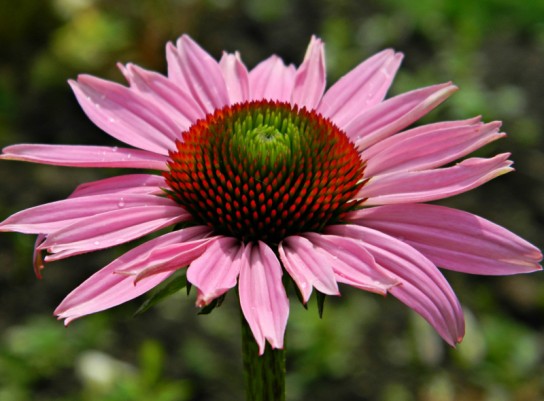
Place of landing is of great importance. It should not be under scorching sunbeams especially if there is no snow for a long time in winter. Also, the site should not be located where melt water flows in the spring, since the seeds will quickly wash out and there will be no harvest. During planting, you need to monitor the density of the seeds. This figure should be higher than in the spring.
It is recommended to start preparing the ground as early as September. Preparation consists in digging the soil, fertilizing it and making beds. If the seeds are very small, the depth should be 1 cm, if large - about 5 cm.
In this state, the land remains until the end of November, and when it is already completely frozen, you can sow seeds thickly in the beds, add humus or peat mixed with sand there. When the flowers already have several leaves in spring, the beds can be thinned out so that in further plants had the opportunity to develop well.
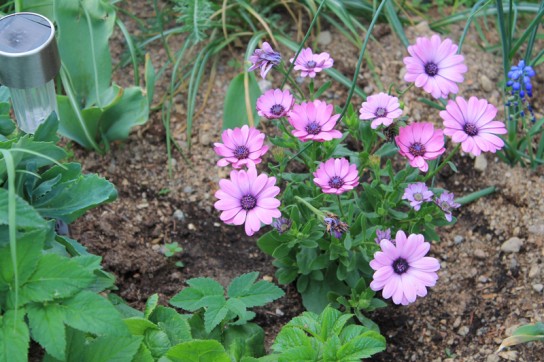
One-year-old flowers that can be planted for winter include medicinal calendula, fragrant mignonette, keeled chrysanthemum, snapdragon, Chinese aster, and carnation, to name a few.
Such flowers give even best harvest than annuals, so it is very useful to plant them in the fall. True, the choice of perennials must be taken very seriously, since they quickly germinate and strengthen, but give color only after a few years. If there is no desire or opportunity to wait for the harvest for so long, the variety of flowers should be express, that is, one that blooms next spring.

Perennial flowers are recommended to be planted when the soil freezes a little, that is, somewhere at the end of October. The principle of sowing is similar to how annual plants are planted. At the same time, it is very important to compact the earth a little, thus protecting them from various pests.
When the snow leaves with the onset of spring, it is recommended to cover the area with flowers planted in autumn with a film, which is removed after the first shoots appear. If there are already about 4 leaves on the flower, the flowers need to dive in order to strengthen the root system.
Among the perennial flowers that need to be planted in autumn, it is worth highlighting bluebells, alpine aster, aquilegia, euphorbia, oriental poppy, lupine and others.
If the flower grows from a bulb, and gives color in the spring, it should be planted in early September. Of course, it is important to take into account the geographical location of the site, the climate in a particular area. The main thing is that the seating takes place a month before the first frost.

Since the plants that germinate from the bulbs bloom first in the spring, they are best placed in open areas. Such flowers are also called primroses, they include hyacinths, tulips, daffodils, anemones, primroses, irises.
By the way, the bulbs of the latter need to be distributed in early September, sprinkled with ashes before planting in the soil. The same goes for peonies. Regarding seeds, autumn sowing it is better to prepare poppy, liatris, digitalis.
summer shoots
Flowers that please with their color in summer period, can be planted shortly before frost. For example, good option is a lily bulb that needs to be replanted every few years. Flowers growing from seeds are chamomile, lavender, delphinium and others.
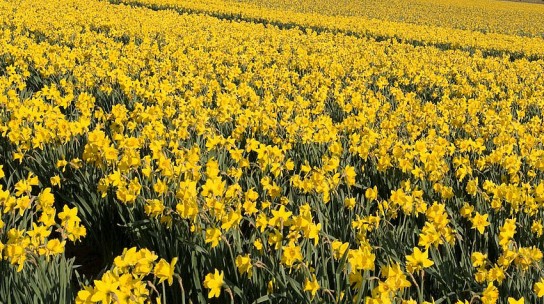
Whatever flowers are planted for the winter, it is very important to prepare the land in time, dig it up, apply fertilizers and the necessary vitamins. best period for this is September.
Planting annual and perennial flowers before winter has many advantages. Seeds are well hardened, and in the spring they give high-quality seedlings, characterized by good growth, and resistant to frost and disease.
Time is fleeting, only it was spring, and you look already and autumn is just around the corner. You don’t have time to look back, but it’s October, rainy November, and there are frosts and winter. Everything in the country freezes until the new spring, and garden work seems to have been discontinued long ago. But it seems so only at first glance.
In autumn and even at the beginning of winter, you can sow flower seeds. Planting before winter has many advantages over spring sowing. If you have never encountered this, I advise you to take a closer look at the idea.
It only seems to us that the seeds of flowers are defenseless, and are destroyed by frost. They contain a program of adaptation to any conditions, and germination in any moist hole, as soon as the earth warms up enough from the spring sun.
Benefits of planting flowers before winter
Seeds sown before winter go through a school of good hardening. In the spring they give high-quality shoots that resist any disease. Plants will be strong, resistant to adverse weather conditions.
I've been spending a year sowing flower seeds before winter, and only confirm the correctness of this idea. Young shoots in spring are resistant to early frosts, and form a well-developed healthy root system. This allows the roots to grow deeper and draw moisture from deeper layers at a time when drought dehydrates the topsoil. Such flowers need less watering, and are able to resist weeds.
Conducting planting flowers before winter, I save myself from having to think about it in the spring, worrying whether the earth has warmed up well in order to sow the seeds, whether the frost will hit and the young shoots will freeze. And if it happens that you hesitate with planting in the garden, and you don’t plant seedlings of flowers on time, then it will be too late to do this, a drought will come, the flowers will not take root well. They will bloom late, and the color will be weak and unsightly. Autumn plantings all these shortcomings are completely eliminated. Seeds will germinate at the moment when it is most expedient, seedlings will appear naturally, according to the natural cycle.
Disadvantages of autumn plantings
Of course, not everything will rise, which sown before winter. Compared to special seedling cultivation, I can note the low germination of seeds. However, if I do this planting method every year and use only my own seeds, they will adapt over the years. will happen natural selection, resulting in the development of new varieties that are resistant to our winters. Then every year the seedlings will sprout more and more friendly. The plants will all be strong and healthy.
In winter, it is desirable to sow only cold-resistant annuals, while the main rule is to throw seeds into already frozen soil. Otherwise, with a slight warming in the middle of winter, they can ascend, and in the future, of course, they will die.
1. Anemone. 2. Crocus. 3. Spring spring.
4. Anemone. 5. Snowdrop. 6. Muscari. 7. Scilla.
8. Small bulbs of narcissus. 9. Kandyk.
12. Chionodox. 13. Spring white flower.
14. Hyacinth, 15. Tulip. 16. Narcissus. 17. Lily.
18. Erelgurus. 19. Grouse, (fritillaria)
What flowers to choose for planting before winter?
The choice for autumn planting flowers is extremely large: these are annual crops, biennials, and perennials.
Ideal for fall sowingmarigold. From the rest annual crops You can sow the following types of flowers before winter:
- amaranth,
- verbena,
- alyssum,
- cornflower,
- antirrinum,
- mignonette,
- nasturtium,
- dried flower,
- Chinese aster,
- kosmeya,
- delphinium,
- matthiola,
- iberis,
- purslane,
- chrysanthemum,
- calendula,
- mallow,
- rudbeckia,
- poppy,
- nigella,
- levkoy,
- morning glory,
- clarkia,
- escholzia,
- lavater.
This is not the whole list of annuals. flower crops that can be planted before winter.
From biennial crops best suited for autumn sowing:
- forget-me-not,
- daisy,
- viola,
- mallow foxglove,
- turkish cloves,
- bell and others.
From perennial flowers feel free to plant the following types before winter:
- primrose,
- bell,
- carnation,
- aster,
- geuchera,
- lumbago and other resistant species.
Dear gardeners, connoisseurs of beauty, remember thatflowers planted before winter save your time, and also grow more beautiful, lush and strong.
Material provided by the site "In the garden with your own hands" handmade-garden.com Tips and experience of working with your own hands in the garden.
As a rule, in the autumn period, many summer residents try to close the season and prepare the garden and soil in the winter. In fact, a lot of work can be done during this period. We suggest considering flowers that can be planted before winter and the advantages of this planting method.
What flowers are planted before winter: the advantages of autumn planting
The first and most obvious positive point is the hardening of plants. If you sow the seeds in the autumn, they will give high-quality seedlings, which in the future will ensure rapid growth of flowers and resistance to different kind diseases. This is a good prevention of problems during spring frosts. In addition, this planting method allows the root system to grow healthier and longer. deep level. Now let's take a closer look at what flowers are planted in winter and planting features.
- Planting annuals. The most important rule is to sow in frozen soil. If this rule is neglected, the ground may not freeze completely and sprouts may sprout from the seeds during thaws. Plan your site before planting. Remember that during the spring thaw, your crops can be washed away by water. Remember about the lighting of the site, so that the flowers are not under the scorching sun. Seeds should be sown more densely than during spring planting. They start work at the end of September. The soil is dug up, the necessary fertilizers are applied and furrows of the right size are made. Seeds are applied after the soil has frozen. Next, a mixture of the following composition is poured: compost, humus, sand and peat. What annual flowers are planted before winter: Chinese aster, cornflower, delphinium, bitter Iberis, officinalis calendula, kosmeya, lavatera, snapdragon, seaside malcolmia, mattiola bigorya.
- With perennials, things are much easier. Seed germination is much higher, which saves money and time. It is best to plant them in the period from mid to late October. It is necessary to prepare the land in September by the method already described. After the snow has melted, cover your flower bed with foil. This is necessary to protect the seeds from birds and spring rains. As soon as the first shoots sprout, remove the film. After the plants release the first few leaves, it's time to plant them. From perennials suitable: aconite, alpine aster, buzulnik, gypsophila, bell, lupine, euphorbia, primrose, popovnik.
Is it possible to plant asters before winter?
Absolutely - the answer is yes. For these purposes, use the seed method of planting. The most important and important point how to plant asters before winter: sow as thickly as possible. This is done to prevent seed germination. In this case, flowering is likely to come a little earlier than usual. If your seedlings have hatched without loss, planting them will not be a problem. And if your seeds sprout very rarely, plant new ones in places with gaps.
Can marigolds be planted before winter?
This plant is very thermophilic and planting before the cold weather may fail. The fact is that the seeds absorb moisture very much, and in the autumn they can rot, as the temperature drops and the plants do not have enough heat. The only way 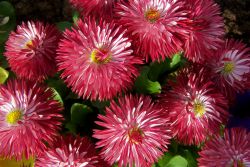 try this method - sow seeds in greenhouse conditions.
try this method - sow seeds in greenhouse conditions.
When to plant lilies before winter?
If you decide to plant this flower before the cold weather, you need to hurry. by the most best time when you can plant lilies before winter, September is considered. The bulb should be planted immediately after dividing, so that it does not have time to dry out. If it is not possible to start planting immediately, place the bulbs in damp moss or sawdust. When planting, carefully select only healthy scales and bulbs.
The troublesome summer has passed, the harvest has been harvested, garden work is almost completed. Quietly crept restless and beautiful autumn.
It's time to start next season to enjoy the first gifts of our garden in the spring. After all, every summer resident knows how there is not enough free time in the spring - every hour is precious.
So why don't we make it easy for ourselves spring work and not to spend our favorite vegetables and flowers.
- Sowing before winter Suitable for cold hardy crops. These are those plants whose leaves do not have pubescence (the edge of the leaves protects the plants from heat).
If such species are planted in the spring, they will sprout after a month.
Thanks to winter sowing, we gain time - the seedlings of our winter-hardy vegetables will appear earlier (by about 2-3 weeks), which means the harvest too.
Seeds planted in autumn will undergo winter hardening and vegetables grown from them will better tolerate frosts.
Sowing before winter - pros and cons
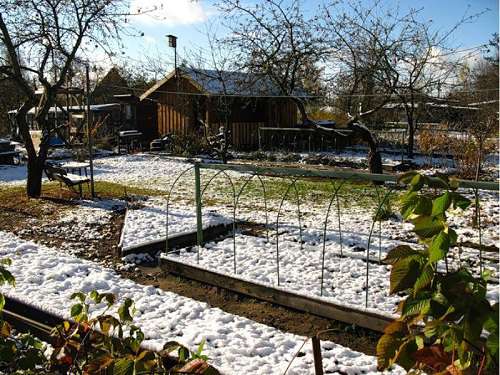
And why are we needed at all? autumn chores? Maybe leave everything for the spring?
Well, no, after all, having correctly selected and correctly done sowing in the fall, we will get many advantages:
- Frost-resistant plants will sprout together, they are stronger and hardier.
- Vegetables obtained from such crops are more attractive in appearance.
- In the spring, we will free ourselves more time (after all, some of the varieties will already be safely sown / planted).
- Considering that the sowing crop before winter is harvested 2-3 weeks earlier, it is possible to grow early-ripening types of vegetables on the vacated beds.
But is everything so perfect? Of course not. Podzimny sowing also has "pitfalls".
After all, it is not always possible to guess what winter and spring will be like. If the winter period is prolonged, the soil is compacted, which inhibits the success of seedlings.
Yes, and it is quite difficult to determine the exact timing of sowing. The modern climate is an unpredictable thing, winter can come suddenly, or it can “please” gardeners with slush.
Therefore, there is a risk of freezing or too early germination of seeds that will die during the first frost.
But these unpleasant surprises can be smoothed out and a great harvest can be harvested.
To do this, you need to know some of the nuances of winter sowing. We will tell about this.
So, seven competent steps of this event:
Step 1. Choose the "winter residents" of the garden
What to sow before winter? There are a lot of cold-resistant crops:
- Carrots (Incomparable, Nantes 4, Moscow Winter, Vitamin 6, Shantane 2461). The winter carrot fly is not afraid of the carrot fly (it is not damaged by it). Sowing carrots before winter gives larger and vitamin-enriched fruits.
- Beets (Egyptian flat, Cold-resistant 19, Moscow winter, Podzimnyaya 474, Losinoostrovskaya 13).
- Lettuce head (Berlin yellow, Red head).
- Turnip (small nested varieties: Danilovsky 312, Myachkovsky, Strigunovsky).
- Spinach (Victoria). Spinach is not at all afraid of the cold. Fresh greens can please you with a harvest even in winter (it is harvested from under the snow).
- Dill (Gribovsky).
- Garlic (purple-striped).
- Parsley (leaf Ordinary, root Bordovician sugar).
- Pasternak (Student, Round). In such a culture, seeds can very quickly lose their germination capacity - winter sowing will only benefit parsnips.
- Radishes (Persistent, Rose Red).
- Bow (Ellan, Bessonovsky, Stuttgarten, Arzamas, Strigunovsky, Danilovsky, Myagkovsky 300). Onion sets, especially small ones (up to 1 cm in diameter), are very difficult to store until spring, they just need to be planted for the winter.
Suitable for sowing before winter cumin, fennel, sage, katran, salad mustard, rhubarb, sorrel, watercress, horseradish roots, Chinese cabbage, borago (borage), corn, sunflower.
Have you ever sowed flower seeds before winter? So be sure to try it, because their autumn planting has its advantages - plant hardening, better seedlings, good growth, resistance to diseases and weather conditions.
The following annuals can be sown before winter: alissum, aster, cornflower, godetia, iberis, cadendula, kosmeya, poppy, Damascus nigella, escholcia, clarkia, amaranth and some others.
Of the perennial flowers for winter sowing, seeds of such crops as: gaillardia, doronicum, Carpathian and peach-leaved bells, lychnis, lavatera, carnation, chamomile, obrieta, aquilegia, delphinium, primula, yarrow, arabis and others are suitable.
Step 2. Choose a place
We need areas that dry quickly in the spring, are fairly flat in terrain, with good drainage and highly fertile soil.
These should be warm elevated zones with a slope towards south side protected from cold winds by thick hedges or trees.
Choose places where heavy snow does not accumulate. In spring, it will melt for a long time and can flood crops.
Advice. If the selected site is located in a lowland (or with high groundwater), make the beds raised (30-40 cm high). Ideally, the height of the beds should be up to 15 cm (except sandy soil, sandstone beds are made a little higher).
Step 3. Determine the timing
With sowing before winter, it is better to be late than to hurry. The main condition for such seeding is that the plants do not germinate in the fall.
The best time for winter landing is when the soil temperature drops to + 3 ° C (at a depth of about 5 cm), when warming is no longer expected.
In this case, the air temperature should be about 0 ° C. The most optimal time: a week and a half before the onset of cold weather.
- In the conditions of the central Non-Black Earth Region (the European part of Russia), such a period begins in mid-October and lasts until early November (in the northern regions two weeks later, in the south from mid-November to early December).
It is very important not to miss these days, it is during such a period that the seeds planted for the winter will not be able to germinate in the fall and will wait in the beds for the onset of spring.
If you hurry, the seeds will begin to germinate already in the autumn period and will die with the onset of cold weather.
Step 4. Prepare the beds
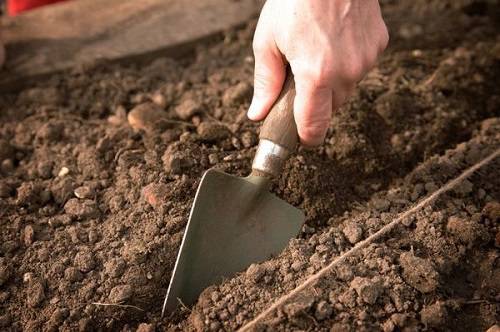
We need to prepare the soil in advance, even in warm weather (September-October).
For sowing before winter, more stringent requirements are imposed on the soil than with spring sowing.
♦ Regular bed. We will use it for winter sowing in the southern regions of vegetables and herbs:
- After harvesting, the soil must be carefully dug up, large clods of soil should be broken.
- If it is very dry, water the soil. Water will wake sleeping weeds, and they will make themselves felt.
- Completely clear the soil of emerging weeds.
- Apply fertilizer (humus, peat, or compost).
- Cold-resistant crops like loose soil, so we need to add additional baking powder (sawdust or sand) to the ground. The baking powder is mixed with fertilizer.
- Level the ground well with a rake.
- Make grooves to a depth of 1-10 cm (the depth depends on the type of plant).
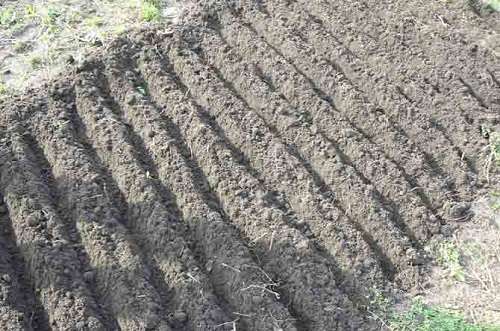
♦ Warm bed. Its arrangement practically does not differ from the usual one.
The only difference is that we need to remove the soil from the trench and lay manure (goat, horse and sheep) in a layer of 30-40 cm.
Pour fertile soil 20-30 cm high on top of it and water it very well.
Then mulch the prepared grooves.
- Rotting natural components will abundantly supply the earth with heat and create the most comfortable conditions for sowing before winter.
Seeds can also be planted in already frozen grooves, filling them with fresh earth from above.
To do this, save the soil in advance. Prepare and mulch (spruce branches, leafy twigs).
We will cover the beds with mulch to a layer of about 15 cm when cold weather sets in.
In the spring, the mulch is removed immediately after the snow melts (if it is not removed on time, shoots will be too late and rare).
Advice. If you are just starting to develop a new site, set aside one bed for winter sowing, plant the rest with green manure until spring.
Step 5. Seed preparation
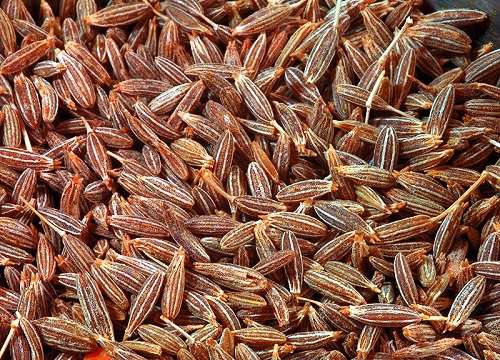
Seeds for winter sowing are used absolutely dry (otherwise they will begin to germinate ahead of time).
They are sown on prepared beds and covered with a layer of 1.5-2 cm of peat, compost or fertile soil.
- Many gardeners advise using coated seeds (placed in clay tablets). You can experiment with such seeds, because the clay capsule will serve as additional protection for the seeds from hungry rodents.
How many seeds do you need? Here opinions are divided. You can hear from experts that when sowing before winter, the number of seeds should be increased by 30-50%.
But there is also the opposite assertion that an excess of seeds will oppress their fellow tribesmen. Therefore, the most optimal solution- sow seeds in the usual amount (as in spring).
The trick of an experienced gardener. If you did not have time to sow the seeds before the first snow, they can carry out the original stratification:
- After the arrival of consistently cold weather, pack the seeds in linen bags and dig into the ground to a depth with a spade bayonet.
- In the end winter period take them out, dry them and plant them as usual (spring sowing).
Thanks to this method, the seeds will receive additional hardening and they will not be afraid of various diseases.
But this method is acceptable only for parsnips, carrots, cumin, katran, onions (of any kind), lovage, fennel, parsley, dill and tomatoes.
Other cultures do not need stratification.
Step 6. Sowing before winter
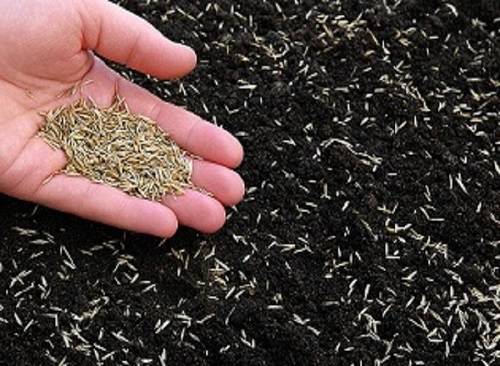
On lighter soils, seeds should be planted half a centimeter deeper than you do in the spring (including a layer of mulch).
Mulching is a must - this is a guarantee of the safety of seeds in the cold and getting good and friendly seedlings in the spring.
Mulch consumption is up to 4 kg per sq. m. The very depth of seeding depends on the type of plants:
- Celery: its seeds are very small, so when sown, they are only sprinkled with compost / peat. If the seeds are deepened into the ground, they may not germinate.
- Beets, leaf parsley, dill: 2-2.5 cm.
- Onion sets (bulb diameter up to 1 cm): 3-4 cm.
- Black onion, dill: 1.5-2 cm.
- Leek: 8-10 cm.
- Carrots: 1-1.5 cm.
- Spinach: 2.5-3 cm.
Advice. If unexpected snow falls, do not be discouraged. Just rake it and sow before winter, sprinkling the seeds with fertile soil, peat, or compost. They'll make it through the cold.
Carefully place the seeds on the prepared, frozen beds and sprinkle with warm soil.
Lay a layer of mulch over it. It is not necessary to water the crops - in the spring, the awakening plants will have enough snow melting.
Seeds moistened in autumn may swell and die in the cold.
Nuances of winter sowing of various crops.
♦ Celery. A fragrant vegetable requires a very loose and humus-enriched earth. It should be sown before winter in bright, open areas.
We dig up the soil by 25-30 cm. It is necessary to plant the seeds according to the scheme 45x10 cm.
♦ Beets. Nutritious beetroot will get used to areas where organic fertilizer has not occurred for 1-2 years. Beets love mineral supplements.
In order for our beets to grow healthy, acquire an intense color, plant them for the winter in lighted places, with a deep location of preferred soil waters.
- If the waters are close to the surface, make beds for it about 25-30 cm high. Avoid clay, too oxidized soils. Excess acidity can be eliminated by adding ash, chalk, lime or dolomite flour to the soil.
Beets will feel good after peppers, potatoes, tomatoes, onions and cucumbers.
We dig up the soil by 25-30 cm (at the same time add potassium-phosphorus fertilizers, ash and humus).
But sowing before winter for beets should be done a little later than other crops (late October-early November). Leave a distance between seeds of 7-8 cm. Between rows about 25-30 cm.
Among the people there is a sign according to which it is best to plant beets for the winter - after the foliage has fallen from the cherry.
To further protect the landing from frost, cover it with fallen leaves, sawdust or needles, sprinkle with snow on top (all this must be removed in the spring, as soon as the snow begins to thaw).
Immediately after this, add beetroot nitrogen fertilizer and cover it with a film (remove it after the first shoots appear).
♦ Carrots. This "vitamin factory" really needs fertile soil, so use plenty of peat, humus or compost.
For her, loamy, floodplain soil, slightly oxidized, or neutral will be ideal.
If the earth is heavy, add sawdust (necessarily half-decomposed). The site must be protected from the wind.
- Avoid for winter landing carrots places with slopes. Flood waters will easily wash away the seeds of the plant in spring.
Planting carrots before winter is carried out at the end of November, in slightly frozen ground.
Immediately before sowing, add superphosphate (if the land is depleted, apply nitrogen fertilizer at the rate of 15-20 g per m²).
The soil is dug up to a depth of 25-30 cm. Carrot seeds after sowing before winter are covered with earth 1-1.5 cm high, peat / humus is laid on top 2-3 cm in height. Leave the distance between the ridges 20-25 cm.
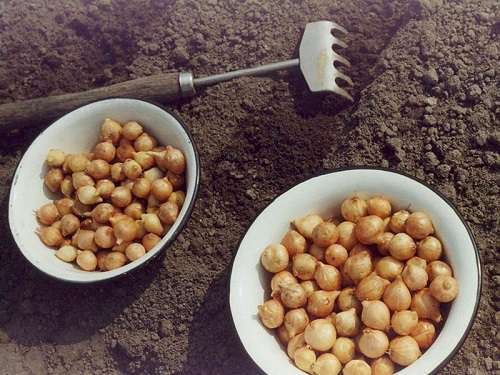
♦ Bow. Onion crops love places where carrots, cucumbers, potatoes or tomatoes used to grow.
When you prepare the soil for the winter sowing of onion crops, use mineral and organic fertilizers.
Make beds for onions a meter by two.
- Onion "on the turnip". Seeding depth 3-5 cm, distance between seeds 10-12 cm.
- Bow "on the feather". Plant the bulbs of the plant with a distance and to a depth of 2-3 cm.
- Onion sets. Plant at a depth of 5 cm, with a distance of 15-20 cm.
For additional soil enrichment, before sowing before winter, add ½ bucket of humus and ¼ bucket of sand.
Onion crops love space, so plant them in a checkerboard pattern. After planting, the soil should be compacted, and with the onset of cold weather, sprinkle with sawdust, additionally lay dry branches on top.
As soon as the onion has made itself felt with the first shoots, it needs to be fertilized.
Use superphosphate (30-40 g/m²). During bulb formation, add potassium chloride (10 g/m²).
In warm spring, it should be watered 2-3 times a week (consumption 5-10 l / m²).
As soon as the onion has matured, watering stops.
After 10-14 days, it must be carefully dug up, cleaned from the ground and left in the garden for 1.5-2 weeks.
Then tie it into braids or cut the dried feathers 3-4 cm from the bulb.
Store our onions in a dry room at normal room temperature.

♦ Garlic. Garlic winter crops are planted with bulbs (air bulbs) and cloves.
Garlic needs neutral, very loose soil, with deep soil water.
Places after cabbage, tomatoes, cucumber, pumpkin, pepper, eggplant are suitable for garlic.
- It is impossible to do garlic sowing before winter in areas where manure was applied this year - the plant can give abundant tops and looser heads.
teeth more large size deepen into the ground by 5-7 cm.
Garlic bulbs are planted 3 weeks before the onset of cold weather, air bulbs are placed in the ground by 2-3 cm. A distance of 20-25 cm is left in the aisles.
To plant garlic before winter, the soil should be abundantly fertilized with compost (15-20 l per m²), before planting, add ash (1-1.5 l per m²). Or potash-phosphorus fertilizer(15 g/10 l of water per m²).
If your soil is too heavy, add sand. For mulching, it is better to use fallen leaves or spruce branches.
Step 7. What to do in the spring
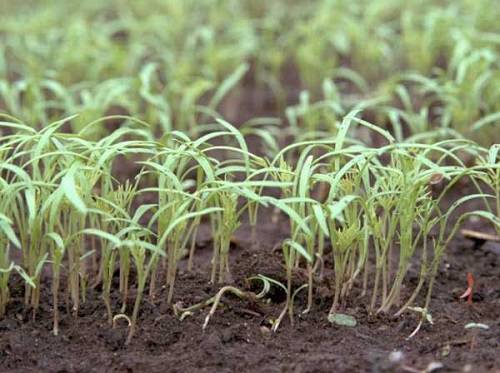
In early spring, as soon as our first sprouts appear, we thin out the plants. If seedlings appeared too early, the beds can be covered with agrofiber or greenhouse film.
- Agrofibre is more successful in the use of sowing before winter, as it perfectly passes air (you can not be afraid of unnecessary overheating) and such a shelter does not require the installation of a frame.
In the future, we only need to clear the plantings of weeds and water our future crop.
Sprouts can be fed organic fertilizers. If you notice that shoots are rare and significant screenings are observed, the plots can be seeded.
Very often winter sowing is combined with further spring planting.
Advice. We cannot predict good germination. If until May you did not notice the activity of winter sowing, carry out duplicate sowing. In the south, successful/unsuccessful winter sowing can be judged already in early April.
Beware of voracious moles! Protect your plantings from them with repellent pellets, smoke bombs or ultrasonic barriers.
Other pests and diseases do not threaten our early shoots.
A harmful aphid can make a problem, but almost always outbreaks of its activity occur at a time when the crop is already successfully formed.
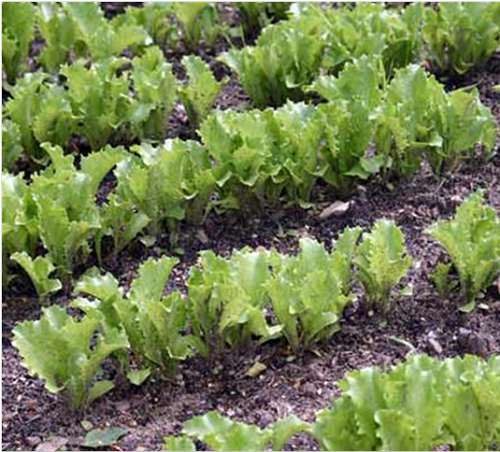
Now, dear readers, you know how to winter crops plants. You may find these activities very risky.
But this is not entirely true if you carefully consider these simple landing rules and diligently follow them.
Don't be afraid to experiment! Plant at least a couple of beds before winter and you will see how much easier it will be for you in the spring.
And now I propose to look short video on this topic.
See you soon, dear readers and good luck with your landings!


